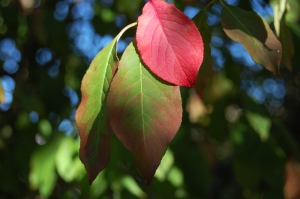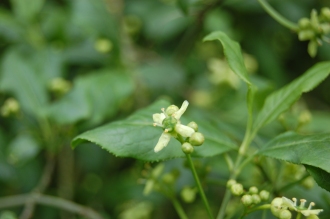Position: Full sun to shade
Flowering period: Early summer
Soil: Moist, well drained
Eventual Height: 20cm (10m with support)
Eventual Spread: Indefinite
Hardiness: 5a, 5b, 6a, 6b, 7a, 7b, 8a, 8b, 9a, 9b, 10a, 10b, 11
Family: Celastraceae
Euonymus fortunei is an evergreen shrub with a spreading and climbing habit. Its dark green leaves are elliptic with serrulate margins, up to 5cm long and 3cm broad. Its stems will form rootlets which enables it to climb. Its green/ yellow flowers are up to 5mm across with four small petals. Its fruit is a 4 lobed green pod like berry, which splits open to reveal the fleshy coated orange seeds, one seed in each lobe.
Euonymus fortunei, commonly known as Spindle, Fortune’s Spindle or Wintercreeper, is native to east Asia, including China, Korea, Philippines and Japan. In its native habitat it grows in woodlands and scrub. Euonymus fortunei is considered an invasive species in some parts of eastern United States and Canada.
The etymological root of the binomial name Euonymus is derived from the name Euonyme the mother of the Furies in Greek mythology who were the infernal avenging goddesses of the underworld. Fortunei is named after Robert Fortune (1812 – 1880) the plant explorer.
The landscape architect may find Euonymus fortunei useful as an effective evergreen ground cover. It is suitable for dry soils, shady locations, maritime locations and can tolerate urban pollution. Care should be taken when specifying this plant as it can be invasive and will climb tree trunks and other structures.
Ecologically, Euonymus fortunei flowers are attractive to some pollinating insets.
Euonymus fortunei prefers moist, fertile, well-drained soils. It tolerates most pH of soil.
Euonymus fortunei requires little maintenance. It may be pruned at anytime.










